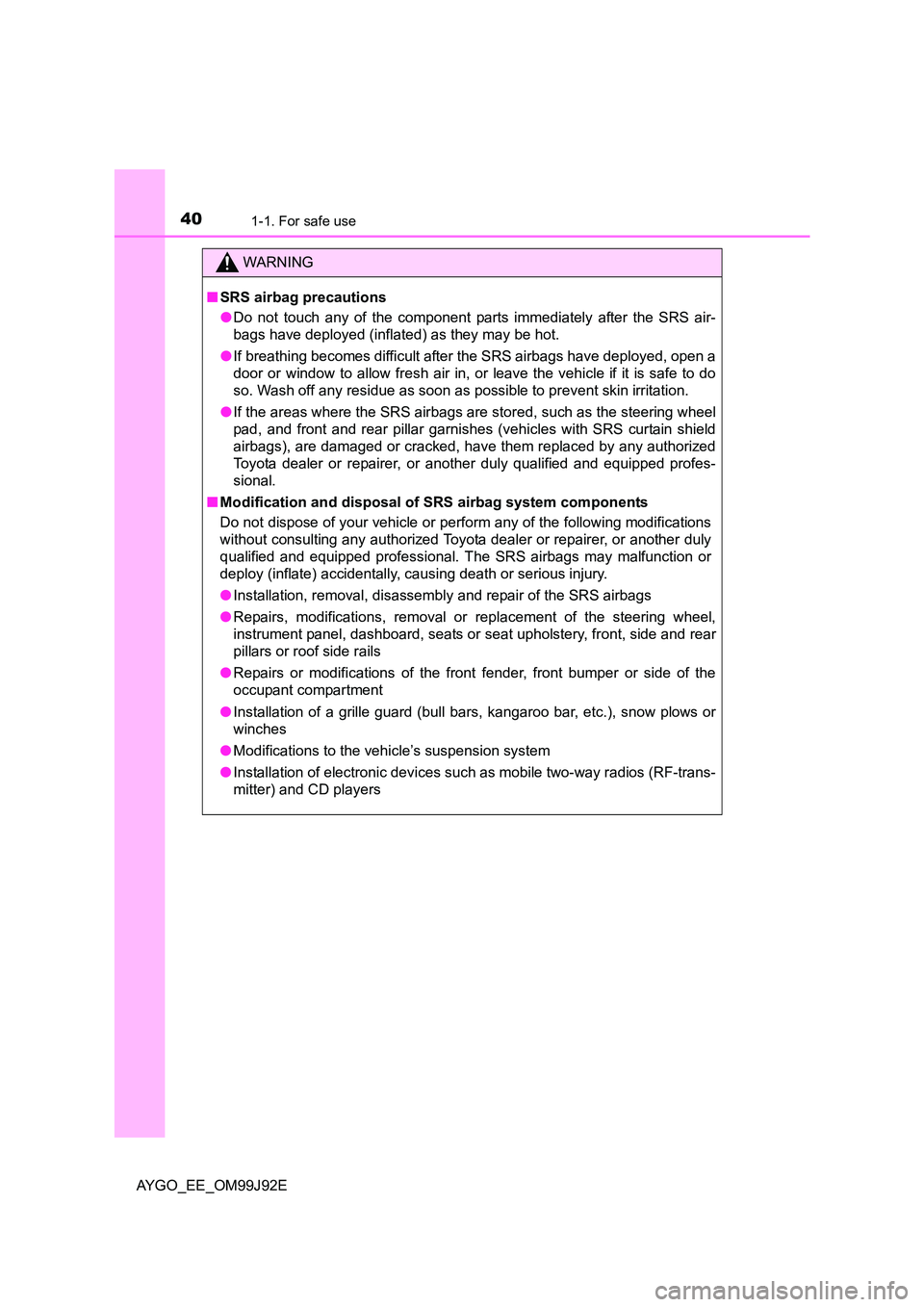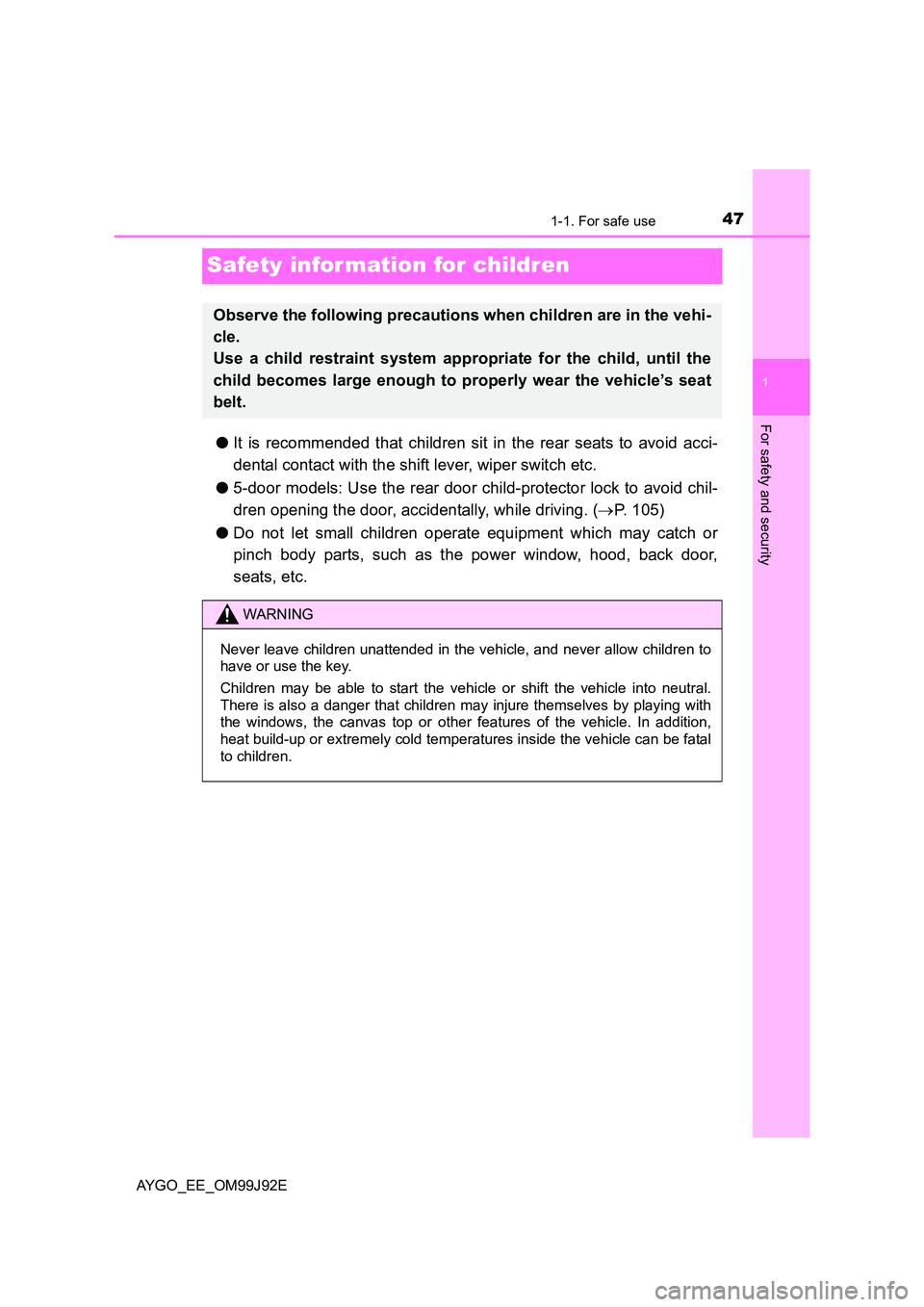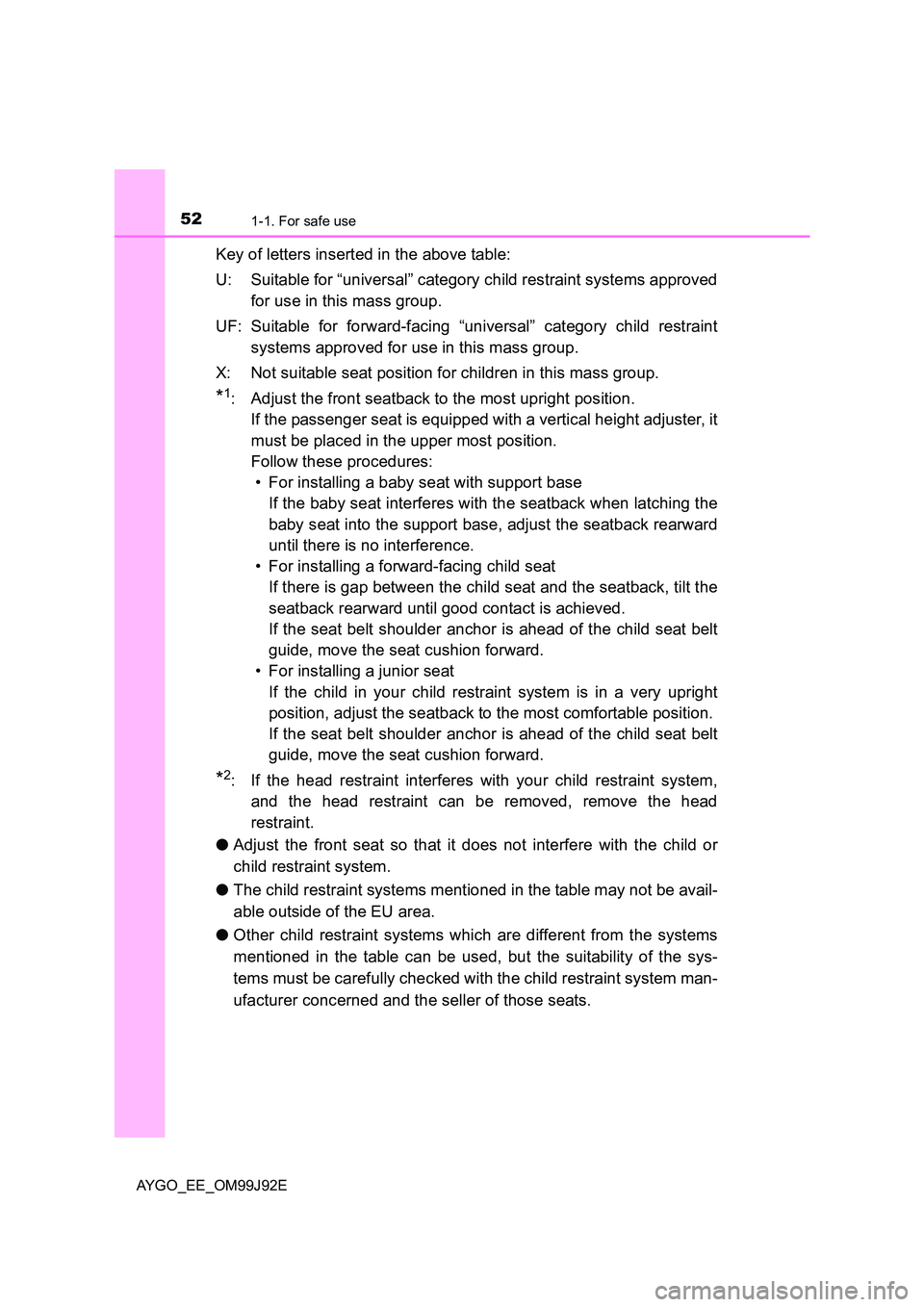Page 40 of 440

401-1. For safe use
AYGO_EE_OM99J92E
WARNING
■ SRS airbag precautions
● Do not touch any of the component parts immediately after the SRS air-
bags have deployed (inflated) as they may be hot.
● If breathing becomes difficult after the SRS airbags have deployed, open a
door or window to allow fresh air in, or leave the vehicle if it is safe to do
so. Wash off any residue as soon as possible to prevent skin irritation.
● If the areas where the SRS airbags are stored, such as the steering wheel
pad, and front and rear pillar garnishes (vehicles with SRS curtain shield
airbags), are damaged or cracked, have them replaced by any authorized
Toyota dealer or repairer, or another duly qualified and equipped profes-
sional.
■ Modification and disposal of SRS airbag system components
Do not dispose of your vehicle or perform any of the following modifications
without consulting any authorized Toyota dealer or repairer, or another duly
qualified and equipped professional. The SRS airbags may malfunction or
deploy (inflate) accidentally, causing death or serious injury.
● Installation, removal, disassembly and repair of the SRS airbags
● Repairs, modifications, removal or replacement of the steering wheel,
instrument panel, dashboard, seats or seat upholstery, front, side and rear
pillars or roof side rails
● Repairs or modifications of the front fender, front bumper or side of the
occupant compartment
● Installation of a grille guard (bull bars, kangaroo bar, etc.), snow plows or
winches
● Modifications to the vehicle’s suspension system
● Installation of electronic devices such as mobile two-way radios (RF-trans-
mitter) and CD players
Page 41 of 440

411-1. For safe use
1
For safety and security
AYGO_EE_OM99J92E
■If the SRS airbags deploy (inflate)
● Bruising and slight abrasions may result from contact with a deploying
(inflating) SRS airbag.
● A loud noise and white powder will be emitted.
● Vehicles without SRS curtain shield airbags: Parts of the airbag module
(steering wheel hub, airbag cover and inflator) as well as the front seats may
be hot for several minutes. The airbag itself may also be hot.
● Vehicles with SRS curtain shield airbags: Parts of the airbag module (steer-
ing wheel hub, airbag cover and inflator) as well as the front seats, parts of
the front and rear pillars, and roof side rails, may be hot for several minutes.
The airbag itself may also be hot.
● The windshield may crack.
■ SRS airbag deployment conditions (SRS front airbags)
● The SRS front airbags will deploy in the event of an impact that exceeds the
set threshold level (the level of force corresponding to an approximately
20 - 30 km/h [12 - 18 mph] frontal collision with a fixed wall that does not
move or deform).
However, this threshold velocity will be considerably higher in the following
situations:
• If the vehicle strikes an object, such as a parked vehicle or sign pole,
which can move or deform on impact
• If the vehicle is involved in an underride collision, such as a collision in
which the front of the vehicle “underrides”, or goes under, the bed of a
truck
● Depending on the type of collision, it is possible that only the seat belt pre-
tensioners will activate.
■ SRS airbag deployment conditions (SRS side airbags) (if equipped)
The SRS side airbags will deploy in the event of an impact that exceeds the
set threshold level (the level of force corresponding to the impact force pro-
duced by an approximately 1500 kg [3300 lb.] vehicle colliding with the vehi-
cle cabin from a direction perpendicular to the vehicle orientation at an
approximate speed of 20 - 30 km/h [12 - 18 mph]).
■ SRS airbag deployment conditions (SRS side and curtain shield airbags)
(if equipped)
● The SRS side and curtain shield airbags will deploy in the event of an
impact that exceeds the set threshold level (the level of force corresponding
to the impact force produced by an approximately 1500 kg [3300 lb.] vehicle
colliding with the vehicle cabin from a direction perpendicular to the vehicle
orientation at an approximate speed of 20 - 30 km/h [12 - 18 mph]).
● The SRS curtain shield airbags may also deploy in the event of a severe
frontal collision.
Page 44 of 440
441-1. For safe use
AYGO_EE_OM99J92E
● Vehicles with SRS side airbags or SRS
side and curtain shield airbags: A portion
of a door or its surrounding area is dam-
aged or deformed, or the vehicle was
involved in an accident that was not
severe enough to cause the SRS side
airbags or SRS side and curtain shield
airbags to inflate.
● The pad section of the steering wheel or
dashboard near the front passenger air-
bag is scratched, cracked, or otherwise
damaged.
● Vehicles with SRS side airbags: The sur-
face of the seats with the side airbag is
scratched, cracked, or otherwise dam-
aged.
● Vehicles with SRS curtain shield air-
bags: The portion of the front pillars, rear
pillars or roof side rail garnishes (pad-
ding) containing the curtain shield air-
bags inside is scratched, cracked, or
otherwise damaged.
Page 47 of 440

471-1. For safe use
1
For safety and security
AYGO_EE_OM99J92E
Safety infor mation for children
●It is recommended that children sit in the rear seats to avoid acci-
dental contact with the shift lever, wiper switch etc.
● 5-door models: Use the rear door child-protector lock to avoid chil-
dren opening the door, accidentally, while driving. ( →P. 105)
● Do not let small children operate equipment which may catch or
pinch body parts, such as the power window, hood, back door,
seats, etc.
Observe the following precautions when children are in the vehi-
cle.
Use a child restraint system appropriate for the child, until the
child becomes large enough to properly wear the vehicle’s seat
belt.
WARNING
Never leave children unattended in the vehicle, and never allow children to
have or use the key.
Children may be able to start the vehicle or shift the vehicle into neutral.
There is also a danger that children may injure themselves by playing with
the windows, the canvas top or other features of the vehicle. In addition,
heat build-up or extremely cold temperatures inside the vehicle can be fatal
to children.
Page 52 of 440

521-1. For safe use
AYGO_EE_OM99J92E
Key of letters inserted in the above table:
U: Suitable for “universal” category child restraint systems approved
for use in this mass group.
UF: Suitable for forward-facing “universal” category child restraint
systems approved for use in this mass group.
X: Not suitable seat position for children in this mass group.
*1: Adjust the front seatback to the most upright position.
If the passenger seat is equipped with a vertical height adjuster, it
must be placed in the upper most position.
Follow these procedures:
• For installing a baby seat with support base
If the baby seat interferes with the seatback when latching the
baby seat into the support base, adjust the seatback rearward
until there is no interference.
• For installing a forward-facing child seat
If there is gap between the child seat and the seatback, tilt the
seatback rearward until good contact is achieved.
If the seat belt shoulder anchor is ahead of the child seat belt
guide, move the seat cushion forward.
• For installing a junior seat
If the child in your child restraint system is in a very upright
position, adjust the seatback to the most comfortable position.
If the seat belt shoulder anchor is ahead of the child seat belt
guide, move the seat cushion forward.
*2: If the head restraint interferes with your child restraint system,
and the head restraint can be removed, remove the head
restraint.
● Adjust the front seat so that it does not interfere with the child or
child restraint system.
● The child restraint systems mentioned in the table may not be avail-
able outside of the EU area.
● Other child restraint systems which are different from the systems
mentioned in the table can be used, but the suitability of the sys-
tems must be carefully checked with the child restraint system man-
ufacturer concerned and the seller of those seats.
Page 58 of 440
581-1. For safe use
AYGO_EE_OM99J92E
Installing child restraints
Seat belts (An ELR belt requires a
locking clip)
ISOFIX rigid anchors (ISOFIX
child restraint system)
Lower anchors are provided for the
each rear seats. (Tags displaying
the location of the anchors are
attached to the seats.)
Anchor brackets (for the top strap)
An anchor bracket is provided for
the each rear seats.
Follow the child restraint system manufacturer’s instructions.
Firmly secure child restraints to the seats using a seat belt or
ISOFIX rigid anchors. Attach the top strap when installing a child
restraint.
Page 91 of 440
91
3
Operation of
each component
AYGO_EE_OM99J92E
3-1. Key information
Keys ..................................... 92
3-2. Opening, closing and
locking the doors
Side doors.......................... 102
Back door........................... 107
Smart entry & start
system ............................. 113
3-3. Adjusting the seats
Front seats ......................... 123
Rear seats ......................... 125
Head restraints .................. 127
3-4. Adjusting the steering
wheel and mirrors
Steering wheel ................... 128
Inside rear view mirror ....... 130
Outside rear view
mirrors ............................. 131
3-5. Opening, closing
the windows and
canvas top
Power windows .................. 133
Rear side windows
(5-door models) ............... 134
Canvas top......................... 136
Page 106 of 440
1063-2. Opening, closing and locking the doors
AYGO_EE_OM99J92E
WARNING
■ To prevent an accident
Observe the following precautions while driving the vehicle.
Failure to do so may result in a door opening and an occupant throwing out
of the vehicle, resulting in death or serious injury.
● Ensure that all doors are properly closed.
● Do not pull the inside handle of the doors while driving.
Be especially careful for the front doors, as the doors may be opened even
if the inside lock buttons are in locked position.
● 5-door models: Set the rear door child-protector locks when children are
seated in the rear seats.